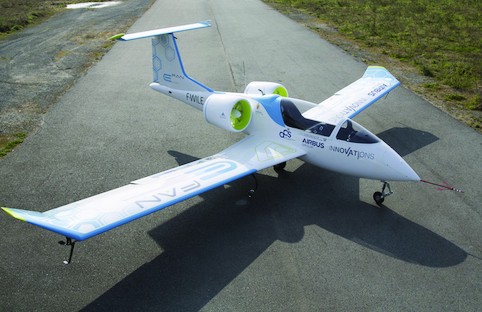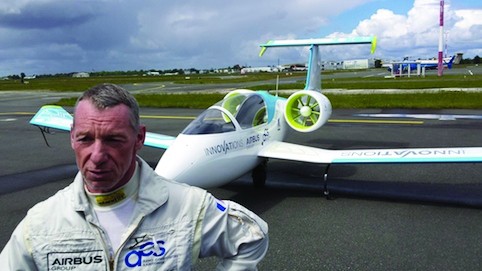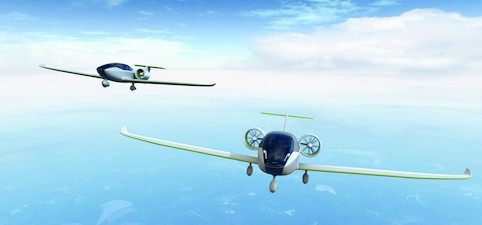The eagerly gathering crowds, the mid-weight politicians and minor celebrities, the unpredictable weather: this could have been the first public test flight of any new aircraft. But there was one obvious difference: the noise, or rather lack of it. Instead of a roar as the two-seater aircraft reached take-off velocity, there was merely a buzz little louder than that of a hair dryer. And once the zippy craft was airborne, it was virtually silent.

We’ve become used to the idea that electric cars will be a key tool in the fight against climate change, even if we are a long way off putting one in every garage. But the idea of electric planes barely registers, even though they’ve existed since the 1970s.
The Solar Impulse, the electric propeller-driven aircraft set to circumnavigate the Earth using nothing but the power of the sun, may capture the imagination but is hardly a model to replace the thousands of kerosene-fuelled jets that criss-cross the globe daily. Instead, biofuels and greater efficiency are usually seen as the way we might reduce aircraft emissions.
So it was a bold step for Airbus Group, on a Bordeaux runway on a rainy Friday morning, to unveil not only a working electric plane but also plans to build a factory producing a commercial version of it. The E-Fan might only be a two-person training plane but it represents a seemingly plausible method for Airbus to bring electric propulsion technology to the aerospace market and pave the way for a much more ambitious project: a 90-seater regional aircraft that really could offer an alternative to our current atmosphere-polluting method of air transport, at least at the short-haul level.

The E-Fan traces its origins back to an earlier milestone in French aviation history: the creation of the world’s smallest twin-engine aircraft, the Colomban Cri-Cri, first flown in 1973. Its tiny weight and low power demand made it an ideal model for experimenting with electric propulsion and Airbus produced the first single-seater, four-engine, all-electric version in 2010, copying the original craft’s toy-like design and aerobatic abilities. The company then embarked on the rather ambitious assignment of creating a two-seater, twin-engine version that could fly for twice as long — in just 18 months.
If you need to plan for the big aircraft you need to start with a small one to develop the technology
Bruno Saint-Jalmes, Head of creative design and concepts, Airbus
This new aircraft (now called E-Fan) was built not just to show that electric propulsion with greater endurance was possible but to create a model that would inform the design of the next generation of environmentally friendly planes. ‘We wanted to have a twin engine because the big Airbus [planes] have twin engines,’ said Bruno Saint-Jalmes, Airbus Group’s head of creative design and concepts. ‘We can work with a single engine but if you need to plan for the big aircraft you need to start with a small one to develop the technology.’
Although the Cri-Cri served as an influence on the design of the E-Fan, the team at the company’s research division, Airbus Group Innovations, quickly realised it couldn’t just adapt the old model and instead needed to go back to the drawing board. ‘[The Cri-Cri] is very small and we could not make all the developments, breeding the aircraft around the battery and the engine,’ said project manager Emmanuel Joubert. ‘So the idea was to draw from scratch a new aircraft.’
The result was a 500kg craft with a wingspan of slightly less than 10m — double that of the original Cri-Cri — and an ability to fly for up to an hour with zero engine emissions (although the full endurance has yet to be proven). Lead designer and test pilot Didier Esteyne claims that, with its mechanical controls, the E-Fan flies just like a conventional plane. ‘The difference is the noise for the people on the ground,’ he said. ‘The sound inside the plane is what I would describe as “smooth”.’

In order to reduce weight and accommodate the heavy lithium-ion polymer batteries, the craft is made entirely from carbon fibre. To reduce noise, the team selected variable-pitch ducted fans with shorter propellers than those of the previous model’s open-fan design. The ducts also increased the static thrust of the engines by reducing losses at the propeller tips (the trade-off being greater weight and lower efficiency at cruise).
Perhaps the biggest engineering challenge, however, was integrating the craft’s 250V batteries — located in the wings just outside the cockpit — with the two 30kW electric motors that drive the fans, as well as the back-up battery and the on-board 24V electrical network that supplies the avionics and radios via a converter. This included developing an optimised, automatic electrical energy management system known as e-FADEC (full authority digital engine control) to simplify monitoring and control and reduce the pilot’s workload — something that will be particularly important for the E-Fan’s role as a training plane. But there were also more basic issues such as the need to protect the electrical connections from the plane’s vibrations, which, although minimal in flight due to the type of engines, were still substantial during taxiing on the ground.
The other great challenge was completing the project within the 18-month time-frame. This meant combining systems engineering with off-the-shelf components rather than designing everything from scratch. ‘We bought cells and developed the battery pack,’ said Joubert. ‘We bought the engine and we developed the ducted fan integrated with the electronics.’
Other elements of the plane were introduced to speed up the development process and enable the team to learn the most it could about electric-powered flight, even if it meant adding extra weight to the craft. ‘I designed a U-tail but we didn’t have any extra time to test it so we used a T-tail where we had more experience,’ said Esteyne. ‘We chose to put on a retractable landing gear, the taxi system and the telemetric system so we had to build a strong aircraft to avoid problems during the test flight. We will make a lighter aircraft after that.’

That lighter aircraft has, in fact, already been envisioned. The E-Fan 2.0 will be the next step on Airbus’s flight map to a commercial electric commercial airliner: a two-seater production model with a two-hour battery life and a range-extending electric generator adding a further hour and a half of flight time using 16 gallons of fuel. The aim is to fly the plane by the end of 2017 and then begin manufacture at a dedicated assembly line in Bordeaux, eventually producing 80 craft a year to sell to pilot-training schools under the brand name VoltAir and at a lifetime price (including fuel) competitive with what’s available today.
A four-seater version will follow soon after and then the work will begin on scaling up the technology to eventually reach the goal of the regional passenger plane, a market segment not currently covered by Airbus. ‘We want to go from 250V and 100A to 1,000-plus volts and thousands of amps,’ said Airbus Group’s chief technical officer Jean Botti, explaining that the key to progress will be a step change in battery technology. ‘In the last 20 years, we have improved by a factor of three the efficiency of batteries so I am expecting to see a lot more progress to come. In the lab there are already batteries capable of what we’re looking for but those are small. We’re looking for something industrial.’
The EU has set challenging goals for the aviation industry: by 2050, new planes will be expected to produce 75 per cent less CO2 and 65 per cent less noise than those made in 2000. The E-Fan on its own isn’t going to enable Airbus to reach these targets and, unsurprisingly, it isn’t Airbus’s only project in this sphere — the company has also partnered with Rolls-Royce in a Technology Strategy Board-funded project to develop a gas-turbine-powered hybrid system. But what E-Fan does represent is a model to bring an electric propulsion system to market in the near term while developing the technologies needed to cut emissions and noise by the necessary amounts in the long term. If it’s successful, the future could be very quiet.




Red Bull makes hydrogen fuel cell play with AVL
Formula 1 is an anachronistic anomaly where its only cutting edge is in engine development. The rules prohibit any real innovation and there would be...